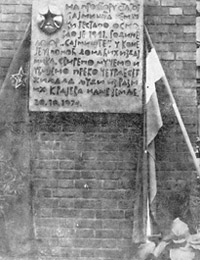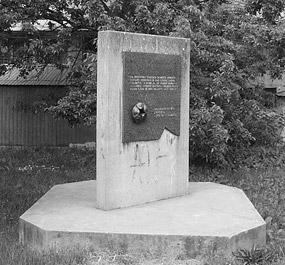English | Srpski
Remembering Semlin, 1945-2008 [1]
As was noted in the pages devoted to the history of the Semlin camp, the murder of Jews at the Semlin Judenlager attracted significant interest from historians of the Holocaust. Christopher Browning describes the events in Belgrade in the spring of 1942 as an important landmark in the escalation of Nazi policy towards Jews. In his view, the use of the gas van at Semlin ‘presaged the efficiency and routinized detachment of the death camps’ and can be seen as ‘the consummation, in Serbia, of a wider plan to destroy European Jews’.
In spite of the important place that it occupies in the history of the Holocaust, in the post war era, Semlin was rarely recognised as a site of Holocaust remembrance. In socialist Yugoslavia, the suffering of Jews tended to be interpreted as a manifestation of the broader ‘reign of terror’ instituted by the Nazis against the civilian population. Like in other communist countries, the Holocaust was regarded merely as a ‘reflex of fascism’ (Zvi Gitelman), and therefore as equivalent, both in substance and consequence, to other instances of Nazi war crimes against civilians. Nazi antisemitism was similarly treated as an expression of racism directed not just at the Jews but also at the Roma and the Slavs (in this case Serbs). As a result, Jewish victims of the Holocaust were, for the most part, subsumed under the category of ‘victims of fascism’, and remembered only in the context of the broader memorialisation of the People’s Liberation War and anti-fascist resistance.
Consistently with this broader perspective, the Semlin camp was treated as yet another place where ‘humanity’s heroic and tragic battle against fascism … left its mark’. The first memorial plaque unveiled at the site in 1974, was dedicated to ‘forty thousand people from all parts of our country’, who were ‘brutally tortured and killed there’. An identical inscription appears on a subsequent memorial, erected in 1984.


Memorials unveiled at Sajmište in 1974 and 1984
Similarly, the annual 9th May commemorations held at Sajmište throughout the 1980s were dedicated to Belgrade’s ‘revolutionary past’, and the memory of ‘victims of fascism’ generally. The principal aim of memorialisation was to ‘reaffirm the moral and social values of the People’s Liberation War and the socialist revolution’ rather than to honour victims of the Holocaust. The motifs of ‘resistance’, ‘Yugoslav unity’, ‘heroism’ and ‘revolution’ dominated the proceedings. Also apparent was a strict hierarchy of victims: fighters, illegal activists, patriots, hostages, and at the bottom of the list, Jews, who were remembered only as ‘Semlin’s first victims’. The uniqueness of their fate and the fact that Jews were the only group of inmates who were the target of systematic and total annihilation was never adequately recognised.
A similar trend continued in the post-communist period, even though Sajmište acquired a very different function and meaning. The late 1980s were a time when the ideological motifs of ‘brotherhood and unity’, Titoism and the cult of ‘the fallen hero of the People’s Liberation War’ gave way to a new, nationalist version of the past, which had at its core the story of the Serbs’ collective martyrdom in the Independent State of Croatia. The gaze of Serbian historians and quasi-historians, politicians, church leaders and the media became fixated on the Ustasha concentration camp at Jasenovac, transforming it into the focal point of national memory. This ideological shift directly affected the remembrance of the Semlin camp, whose history came to be viewed through the prism of Serbian nationalism. Selective and ideologically motivated interpretations sought to assimilate the history of Serbia’s largest concentration camp into the dominant narrative of Serbian suffering in Croatia. Thus, the fact that Semlin was formally on the territory of the Independent State of Croatia (NDH) came to be regarded as the most important fact about the camp’s history. What is more, Semlin was commonly referred to as part of the network of Ustasha death camps and a place from where Serbian prisoners were sent to Jasenovac to be slaughtered.
As early as in 1990, an initiative was put forward for Sajmište to be transformed into the site of the ‘Serbian Yad Vashem”, i.e. the Serbian equivalent of the Holocaust memorial museum in Jerusalem. However, it was only in 1995 (after the Croatian forces captured Jasenovac, making it inaccessible to Serbian nationalists) that Sajmište became a central place for commemorating Serbian suffering in Croatia. Since the mid-1990s, annual commemorations of the Day of Remembrance for the Victims of Genocide (April 22) - which include an Orthodox Christian religious service in memory of (Orthodox) victims of genocide, followed by round-table discussions, lectures, book promotions or exhibitions devoted to Serbian martyrdom at Jasenovac - begin with a wreath-laying ceremony at Sajmište. These commemorative rituals, whose principal object of memory has been the genocide in Croatia, rather than the Holocaust in Nazi-occupied Serbia, contribute to the marginalisation of the Semlin Judenlager, whose tragic history remains excluded from public memory.

The 1995 monument to all those who perished at the Semlin camp, but also to victims of the ‘notorious Ustasha concentration camp Jasenovac’
The fact that over the past sixty years the suffering of Jews has played a peripheral role in the memorialisation of the Semlin camp is directly relevant to current debates about the future of Sajmište as a place of remembrance. As a result of the way in which the Holocaust was remembered both during the socialist era and in the 1990s, there is not, in Serbia today, an appreciation of the Holocaust as a distinct historical event and a unique case of human suffering. This is not least because a large proportion of the Serbian public remains preoccupied with the history of Serbian martyrdom and is consequently inclined to remember victims of the Holocaust primarily as fellow sufferers of Serbs, rather than as a discrete category of victims which warrants its own memorial or museum. This is why any future memorial construction at Sajmište must be part of a broader initiative, the aim of which would be to position the Holocaust into the mainstream of Serbian public memory and have it recognised as an historical event which is worthy of remembrance and veneration in its own right.
Footnote
[1] In this section of the website the word ‘Semlin’ will be reserved for the camp itself, while the Serbian term ‘Sajmište’ will be used to refer to the site of the Belgrade exhibition grounds where the camp used to be located.
